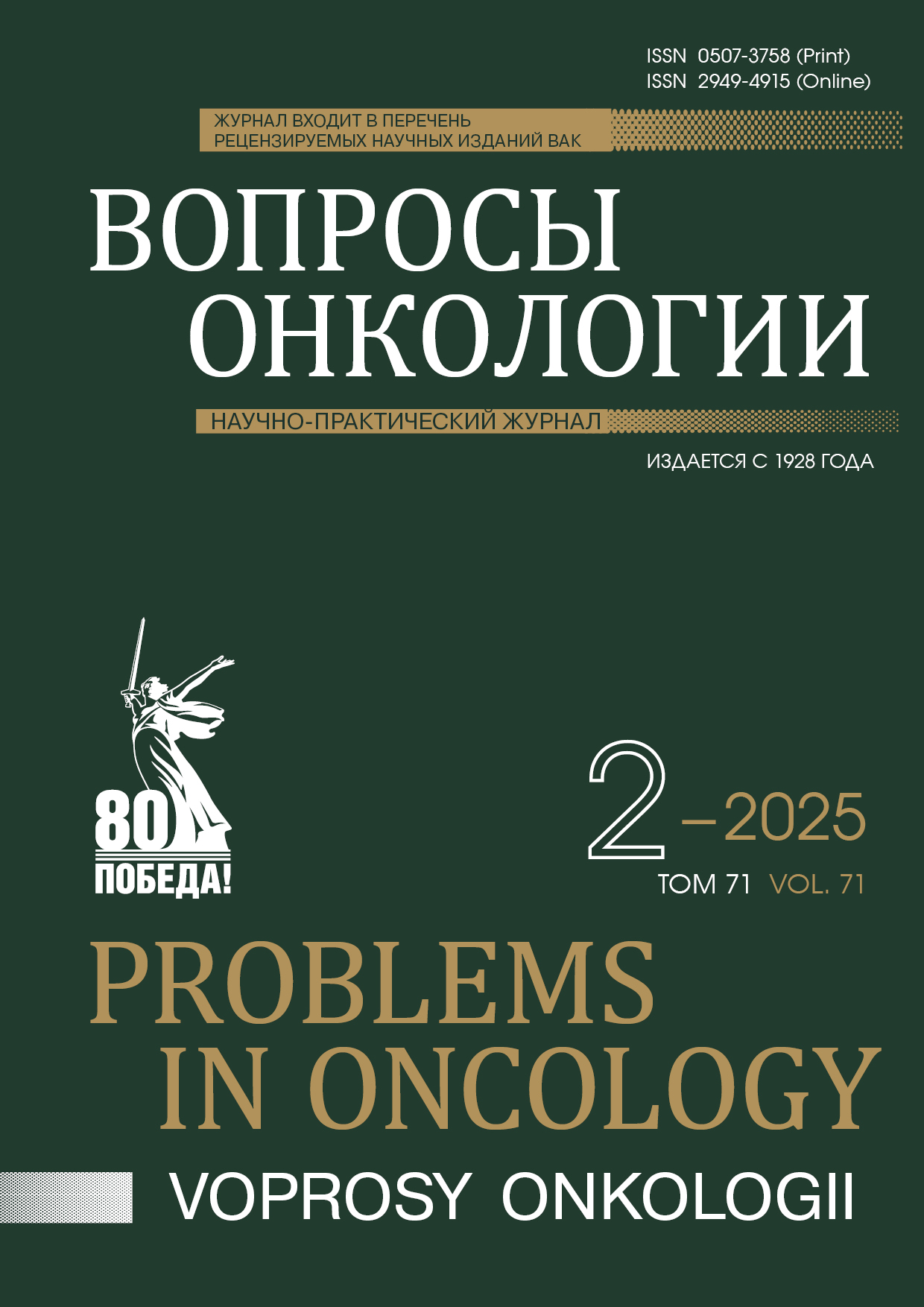Abstract
Introduction. Detection of regional lymph node metastases is an important part of breast cancer (BC) staging, which determines local and systemic treatment. Although diagnostic methods are improving rapidly, there are still several disadvantages to detecting HER2-positive metastases in regional lymph nodes.
Aim. To investigate the potential use of [99mTc]Tc-ADAPT6 for the discrimination of HER2 status in BC patients with metastatic axillary lymph nodes.
Material and Methods. 20 patients with BC (T1-4N1-3M0-1) prior to any systemic treatment were enrolled in this study. Patients were divided into two cohorts based on HER2 status: 12 patients with HER2-positive and 8 with HER2-negative tumors. All patients were injected with 500 µg [99mTc] Tc-ADAPT6 radiopharmaceutical, and chest and upper abdomen SPECT/CT were performed 2 hours after injection. The uptake of [99mTc] Tc-ADAPT6 was assessed by quantifying the maximum standard uptake value (SUVmax) of metastatic axillary lymph nodes (mALN), contralateral axillary area, reference organs (liver, latissimus dorsi muscle (LDM) and spleen) and then determining the ratios of mALN to background, mALN to liver, mALN to LDM, mALN to spleen. The most informative measure was evaluated using ROC analysis.
Results. All the mALN were visualized 2 hours after injection of [99mTc] Tc-ADAPT6. SUVmax of mALN and mALN-to-background, mALN-to-liver, mALN-to-LDM and mALN-to-spleen ratios were significantly higher in patients with HER2 overexpression (р < 0.005, Mann – Whitney test). The most informative cut-off for HER2 status discrimination in mALN according to ROC analysis was mALN SUVmax > 4.22 units (sensitivity of 91.67 % and specificity of 100 %) (р = 0.0003, Mann – Whitney test).
Conclusion. The use of [99mTc]Tc-ADAPT6 is effective in detecting HER2 overexpression in BC patients with positive axillary lymph nodes. The most informative measurement for HER2 status discrimination in mALN according to ROC analysis was mALN SUVmax cut-off > 4.22 units (sensitivity of 91,67 % and specificity of 100 %).
References
Александрова Г.А., Ахметзянова Р.Р., Голубев Н.А., et al. Здравоохранение в России. Стат.сб. Росстат. 2023: 25-62. [Alexandrova G.A., Ahmetzyanova R.R., Golubev N.A., et al. Healthcare in Russia. Stat.col. Rosstat. 2023: 25-62. (In Rus)].
Chang J.M., Leung J.W.T., Moy L., et al. Axillary nodal evaluation in breast cancer: state of the art. Radiology. 2020; 295(3): 500-515.-DOI: https://doi.org/10.1148/radiol.2020192534.
Aurilio G., Disalvatore D., Pruneri G., et al. A meta-analysis of oestrogen receptor, progesterone receptor and human epidermal growth factor receptor 2 discordance between primary breast cancer and metastases. Eur J Cancer. 2014; 50(2): 277-289.-DOI: https://doi.org/10.1016/j.ejca.2013.10.004.
Jadvar H., Chen X., Cai W., Mahmood U. Radiotheranostics in cancer diagnosis and management. Radiology. 2018; 286(2): 388-400.-DOI: https://doi.org/10.1148/radiol.2017170346.
Garousi J., Orlova A., Frejd F.Y., Tolmachev V. Imaging using radiolabelled targeted proteins: radioimmunodetection and beyond. EJNMMI Radiopharm Chem. 2020; 5(1): 16.-DOI: https://doi.org/10.1186/s41181-020-00094-w.
Tolmachev V., Orlova A., Sörensen J. The emerging role of radionuclide molecular imaging of HER2 expression in breast cancer. Semin Cancer Biol. 2021; 72: 185-197.-DOI: https://doi.org/10.1016/j.semcancer.2020.10.005.
Han L., Li L., Wang N., et al. Relationship of epidermal growth factor receptor expression with clinical symptoms and metastasis of invasive breast cancer. J Interferon Cytokine Res. 2018; 38(12): 578-582.-DOI: https://doi.org/10.1089/jir.2018.0085.
Slamon D.J., Clark G.M., Wong S.G., et al. Human breast cancer: correlation of relapse and survival with amplification of the HER-2/neu oncogene. Science. 1987; 235(4785): 177-182.-DOI: https://doi.org/10.1126/science.3798106.
Romond E.H., Perez E.A., Bryant J., et al. Trastuzumab plus adjuvant chemotherapy for operable HER2-positive breast cancer. N Engl J Med. 2005; 353(16): 1673-1684.-DOI: https://doi.org/10.1056/NEJMoa052122.
Swain S.M., Miles D., Kim S.B., et al. Pertuzumab, trastuzumab, and docetaxel for HER2-positive metastatic breast cancer (CLEOPATRA): end-of-study results from a double-blind, randomised, placebo-controlled, phase 3 study. Lancet Oncol. 2020; 21(4): 519-530.-DOI: https://doi.org/10.1016/S1470-2045(19)30863-0.
Pizzuti L., Krasniqi E., Sperduti I., et al. PANHER study: a 20-year treatment outcome analysis from a multicentre observational study of HER2-positive advanced breast cancer patients from the real-world setting. Ther Adv Med Oncol. 2021; 13: 17588359211059873.-DOI: https://doi.org/10.1177/17588359211059873.
Bragina O.D., Deyev S.M., Chernov V.I., Tolmachev V.M. The evolution of targeted radionuclide diagnosis of HER2-Positive Breast Cancer. Acta Naturae. 2022; 14(2): 4-15.-DOI: https://doi.org/10.32607/actanaturae.11611.
Tolmachev V., Grönroos T.J., Yim C.B., et al. Molecular design of radiocopper-labelled Affibody molecules. Sci Rep. 2018; 8: 6542.-DOI: https://doi.org/10.1038/s41598-018-24785-2.
Брагина О.Д., Чернов В.И., Гарбуков Е.Ю., et al. Возможности радионуклидной диагностики Her2-позитивного рака молочной железы с использованием меченных технецием-99m таргетных молекул: первый опыт клинического применения. Бюллетень сибирской медицины. 2021; 20(1): 23-30.-DOI: https://doi.org/10.20538/1682-0363-2021-1-23-30. [Bragina O.D., Chernov V.I., Garbukov E.Y., et al. Possibilities of radionuclide diagnostics of Her2-positive breast cancer using technetium-99m-labeled target molecules: the first experience of clinical use. Bulletin of Siberian Medicine. 2021; 20(1): 23-30.-DOI: https://doi.org/10.20538/1682-0363-2021-1-23-30. (In Rus)].
Тюляндин С.А., Артамонова Е.В., Жигулев А.Н., et al. Практические рекомендации по лекарственному лечению рака молочной железы. Злокачественные опухоли. 2023; 13(3s2-1): 157-200.-DOI: https://doi.org/10.18027/2224-5057-2023-13-3s2-1-157-200. [Tyulyandin S.A., Artamonova E.V., Zhigulev A.N., et al. Practical guidelines on drug treatment of breast cancer. Malignant Tumors. 2023: 13(3s2-1): 157-200.-DOI: https://doi.org/10.18027/2224-5057-2023-13-3s2-1-157-200. (In Rus)].
Wolff A.C., Somerfield M.R., Dowsett M., et al. Human epidermal growth factor receptor 2 testing in breast cancer: ASCO-college of american pathologists guideline update. J Clin Oncol. 2023; 41(22): 3867-3872.-DOI: https://doi.org/10.1200/JCO.22.02864.
Lindbo S., Garousi J., Åstrand M., et al. Influence of histidine-containing tags on the biodistribution of ADAPT scaffold proteins. Bioconjug Chem. 2016; 27(3): 716-726.-DOI: https://doi.org/10.1021/acs.bioconjchem.5b00677.
Bragina O.D., Chernov V.I., Schulga A.A., et al. Phase I trial of 99mTc-(HE)3-G3, a DARPin-based probe for imaging of HER2 expression in breast cancer. J Nucl Med. 2022; 63(4): 528-535.-DOI: https://doi.org/10.2967/jnumed.121.262542.
Bragina O., Chernov V., Larkina M., et al. Phase I clinical evaluation of 99mTc-labeled Affibody molecule for imaging HER2 expression in breast cancer. Theranostics. 2023; 13(14): 4858-4871.-DOI: https://doi.org/10.7150/thno.86770.
Bragina O.D., Tashireva L.A., Loos D.M., et al. Evaluation of HER2 expression in metastatic axillary lymph node tissue of breast cancer patients using [99mTc]Tc-(HE)3-G3. Acta Naturae. 2024; 16(2): 22-29.-DOI: https://doi.org/10.32607/actanaturae.27448.

This work is licensed under a Creative Commons Attribution-NonCommercial-NoDerivatives 4.0 International License.
© АННМО «Вопросы онкологии», Copyright (c) 2025

